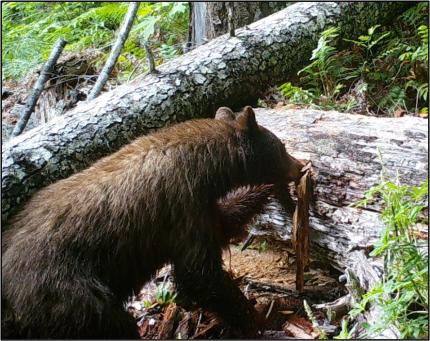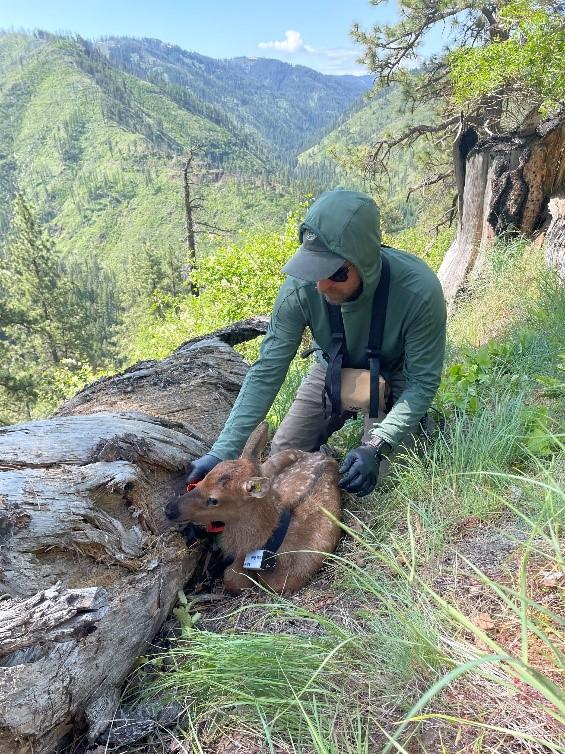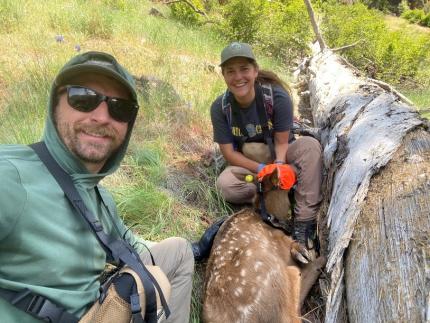Biweekly report Jun16-30 2024 - Region 3 (South Central)
Managing Wildlife Populations
District 8 Fisher Monitoring: District 8 Wildlife Biologist Wampole, with assistance from Washington Department of Fish and Wildlife Intern Flores and Habitat Biologist Bucher, retrieved fisher monitoring stations set in fall 2023. Six of approximately 140 camera stations were collected. A wolverine was detected at one of six sites and marten at two of six sites, no fishers were detected.
District 8 Wildlife Population Monitoring Using Camera Traps: District 8 wildlife biologists have been deploying summer camera traps in remote areas across the district. Biologists will retrieve these cameras before the snow returns.
Region 3 Monarch Butterflies Returning: In the past week, Sunnyside Snake River staff members have observed monarch butterflies returning to areas of the wildlife area that have milkweed. Monarchs have been observed in the Windmill and Hope Valley units.
District 4 Unusual Milkweed Variety: During monarch surveys, District 4 Wildlife Biologist Fidorra located a patch of showy milkweed of an unusual color on the Windmill Unit. Photos were sent to Olympia staff members who consulted with the collections manager of the University of Washington Herbarium who had never seen this color variety. A specimen will be collected and prepared next week.
District 4 Burrowing Owls Give It a Second Go: District 4 Wildlife Biologist Fidorra thought the owl project was wrapping up as the team went to check the final two nests of the year. However, one of the nests failed and the owl pair had re-nested, which is uncommon this late in the year! Perhaps an indication of good food supply, or encouraged by the unseasonably cool temperatures, this owl nest is one of two that will not be ready for banding until late July. Good luck owlets!
District 4 Goose Banding: District 4 Wildlife Biologist Fidorra, along with help from Sunnyside Snake River Wildlife Area Manager Kaelber, District 4 Wildlife Conflict Specialist Hand, Private Lands Biologist Manderbach, volunteers from District 4 Fish Program, volunteers from the Wildlife Program in neighboring districts, and many volunteers from the public trapped and banded geese in District 4. In total, 155 geese were banded between Columbia Park and Hood Park and many previously banded geese were recaptured and released.
Amphibian Monitoring on Sunnyside Wildlife Area: District 4 Wildlife Biologists Fidorra and Hoffman received training from Washington Department of Fish and Wildlife (WDFW) Herpetologist Hallock on amphibian trapping and tadpole identification. Several Species of Greatest Conservation Need were detected. Surveys will be conducted these next few weeks to begin cataloging sites important for these amphibians on WDFW land.
Providing Recreation Opportunities
Region 3 Harder Springs Blackbirds: Region 3 Private Lands Biologist Manderbach was checking the parking area and registration box at the Harder Springs Register to View site in Kahlotus. Volunteers from goose trapping earlier in the month mentioned that they had stopped and seen the tricolored blackbirds there recently on their way into town, so Manderbach took a look and found a few amongst the yellow-headed blackbirds and red-winged blackbirds. Manderbach will work with the landowners to continue to maintain the site and extend the access contract.
Providing Conflict Prevention and Education
District 4 Corral Canyon Elk Area Damage Prevention and Kill Permits: District 4 Wildlife Conflict Specialist Hand delivered the next round of damage prevention permits and kill permits to landowners in elk area 3721. Meetings with landowners were held to discuss changes in crop damage compensation, permit coordination, and hazing strategies.
District 4 Injured Richland Deer: District 4 Wildlife Conflict Specialist Hand responded to a call concerning a possible injured deer at the Columbia Point Golf Course in Richland. The deer was located and showed signs of injury to a lower rear leg and a broken antler, possibly from a vehicle collision. The deer was mobile and was actively feeding, so no further action was necessary.
District 4 Bird in Chimney: District 4 Wildlife Conflict Specialist Hand received a report of a possible squirrel in a fireplace in Finley. The squirrel noises were actually a starling that was trapped in the chimney which was captured and released unharmed.
Wenas Wildlife Area – Tree Removal and Elk Fence Repair: Wenas Wildlife Area Specialist Frame, Habitat Biologist Miller, and Natural Resource Technicians Stoltenow and Janes removed trees that had fallen on the fence along North Wenas Road and removed trees that could potentially fall on the fence in the future. The fence in that section was repaired to prevent wildlife from leaving the wildlife area.
Wenas Wildlife Area – Roza Cable Installation: Wenas Wildlife Area Natural Resource Technicians Janes and Stoltenow installed an additional cable extending from the gate at the entrance to the Roza restoration area. There has been issues in this area with people leaving the green dot road to drive around the locked gate in order to access this area. This will hopefully prevent people from doing this in the future.
L.T. Murray Wildlife Area Elk Fence: L.T Murray Wildlife Area Assistant Manager Winegeart and Natural Resource Technician Blore worked with a master hunter to install an elk return gate in a section of elk fence that routinely receives damage from elk. The elk seem to get in around the Kittitas Reclamation District Road and possibly the creek, but this gate should eliminate future fence damage once the elk find and get used to using it.
Kittitas County Conflict: District 8 Conflict Technician Leuck night hazed elk this month in the Park Creek and Badger Pocket areas. Conflict Specialist Wetzel trapped one bear and immobilized another. Both were relocated to approved areas.
Yakima County Conflict: District 8 Conflict Specialist Wetzel checked for elk in the Tampico and Cowiche areas and inspected fences in those locations. Elk have been reported near orchards and some hay areas but have been easily hazed and have not returned.
Conserving Natural Landscapes
Colockum Wildlife Area Forestry: Colockum Wildlife Area Manager Lopushinsky and Assistant Manager Hagan toured the Clara Lake area with Washington Department of Fish and Wildlife Forester Pfeifle to assess the area for possible forest health thinning work. This is a pristine, high elevation area with no active timber management in the past. After looking at access limitations, habitat conditions, and recent fire events it was decided to not pursue thinning work there in the near future.
Wenas Wildlife Area – Weed Control: Wenas Wildlife Area Natural Resource Technician Stoltenow sprayed Scotch thistle growing in the lower portion of the Black Canyon Trail and some Russian thistle growing around the Wenas Wildlife Area headquarters.
Oak Creek Wildlife Area Weed Control: Oak Creek Wildlife Area staff members continue to chemically control weeds across the wildlife area. Focus continues to be placed on the control of Scotch thistle but other species being controlled include Russian thistle, knapweed, Canada thistle, yellow star thistle, and poison hemlock.
L.T. Murray Wildlife Area Weed Control: A local vegetation management crew was hired to treat weeds along and within 30 feet of green dot roads in the 2022 Vantage Highway Fire area which includes most of the Whiskey Dick Unit and some of the Quilomene Unit. The crew covered all the roads and found yellow star thistle and rush skeleton weed which are two weeds that have potential for serious landscape harm and the wildlife area crew were unaware of their presence.
L.T. Murray Wildlife Area Cultural Resource Surveying: L.T. Murray Wildlife Area Manager Morrison worked with Westland Archaeology which was contracted to do an extensive cultural survey project on the Whiskey Dick and Quilomene units. The information provided from this project will allow the L.T. Murray Wildlife Area management team to better plan and implement restoration activities post 2022 Vantage Highway Fire while protecting sensitive and significant cultural resources.
L.T. Murray Wildlife Area Roads: L.T. Murray Wildlife Area Assistant Manager Winegeart and Natural Resource Technician Blore added barrier rocks to a road that led to an illegal crossing through Cole Creek on the Yakima River Unit near Easton. A new road was quickly created around the barrier so Winegeart and Blore placed two cameras on the crossing hoping to identify the individuals making the new roads over the holiday weekend.
Sunnyside Snake River Wildlife Area Weed Control: Sunnyside Snake River Wildlife Area staff members have been spraying near access sites and roadways to reduce many species of broadleaf weeds. Staff members will be transitioning to mowing interior roadways to reduce fire hazards and then begin wetland mowing activities in a few weeks.
Seed Collection Efforts at Thornton: Sunnyside Snake River Wildlife Area Manager Kaelber, Natural Resource Technician Edwards, and Private Lands Biologist Manderbach joined staff members from the Benton/Franklin Conservation District in a seed collection effort of slender hawksbeard on the Thornton Unit. The collected seed will be used in seedball making events and spread out over other units of the wildlife area. Spiny hopsage and lupine seeds were collected as well.
Antelope Bitterbrush Seed Collection: Sunnyside Snake River Wildlife Area Manager Kaelber and Private Lands Biologist Manderbach collected antelope bitterbrush seed from the Thompson Seeps Unit. The amount and size of bitterbush plants in multiple areas of the unit is promising for seed collection events far into the future. The seed will be used to restore bitterbrush on other wildlife area units and private lands access sites.
Providing Education and Outreach
Wenas Wildlife Area – Durr Road Kiosk: Wenas Wildlife Area Lands and Recreation Specialist Frame and Natural Resource Technicians Stoltenow and Janes installed a kiosk and repositioned a green dot road management sign on the north Durr Road entry to the wildlife area. The green dot road management sign shows information regarding the proper usage of green dot roads and includes the new 2024 Green Dot Road Map. The kiosk has signage that provides information on regulations for recreational use, emergency restrictions, and as well as information about the wildlife area.
Wenas Wildlife Area – New Green Dot Road Maps for 2024: Wenas Wildlife Area Lands and Recreation Specialist Frame has ordered and installed new for 2024, Green Dot Road Maps on all the informational kiosks that are within the Wenas Wildlife Area. These new maps have updated information about the wildlife area and are printed in full color, making it easy for members of the public to read.
Conducting Business Operations and Policy
Region 3 Wildlife Program Safety Training – ATV and UTV classes: Over two days, Washington Department of Fish and Wildlife (WDFW) Safety Staff Members Mundy and Culican held an ATV and UTV Operator Training class at Oak Creek Wildlife Area. More than 15 Region 3 staff members are now trained and certified to safely operate and maintain these machines, which are important for the off trail and often remote nature of some of WDFW’s work.
Supervisor Training: Private Lands Biologist Manderbach attended a three-day supervisor training in Spokane. The three days were packed full of great information and interaction with the class on leadership and supervisory strategies as well as general Human Resource information. The training is intended for new supervisors, but it is also a great refresher course for any supervisor and a great informative training for those who do not supervise.
Other
Sunnyside Snake River Wildlife Area Byron Wetland Tour: Sunnyside Snake River Wildlife Area Manager Kaelber toured the Byron Unit with partners from Ducks Unlimited to deploy data loggers to record water data from multiple ponds located in the eastern portion of the Byron Unit. Data collected will help with possible future wetland development and management. While touring many waterfowl broods were observed along with many species of shorebirds and turtles.

















































































